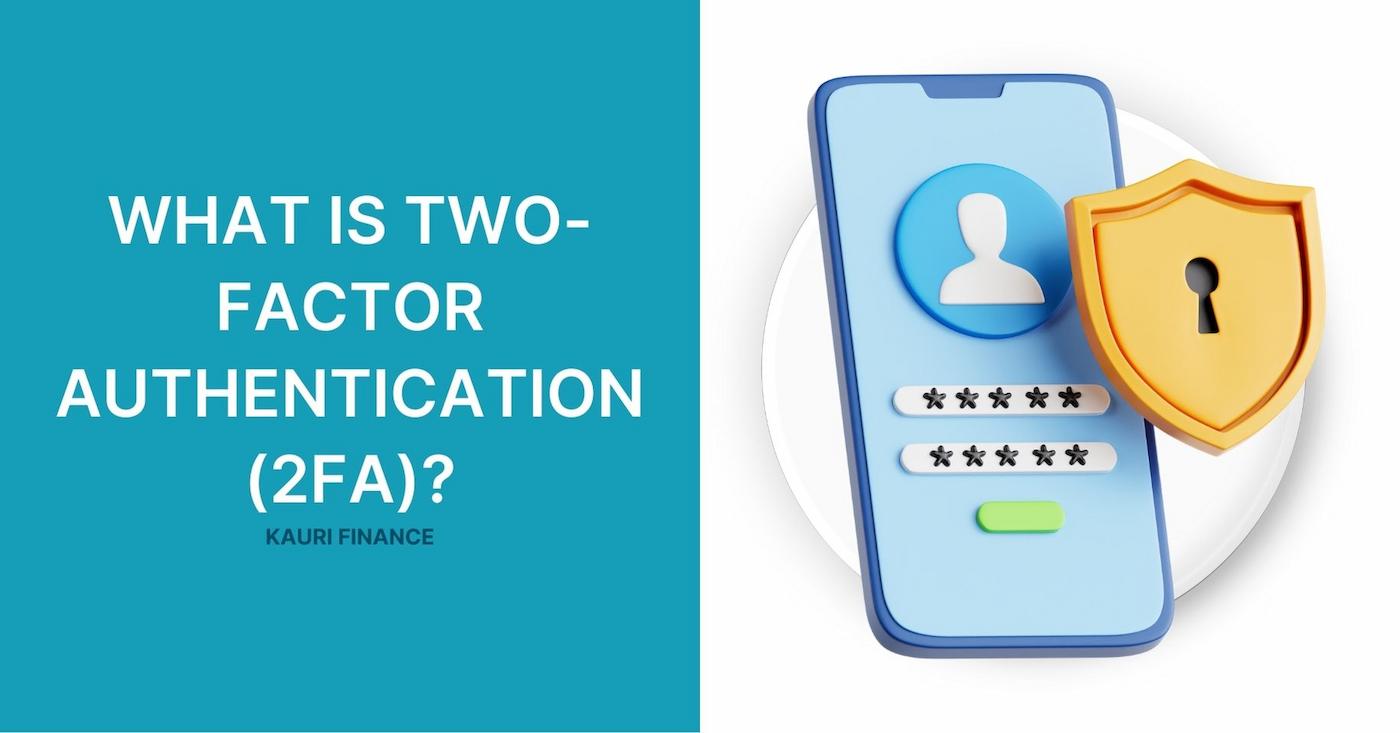
What Is Two-Factor Authentication (2FA)?

Traditionally, protecting our digital identities has relied on the simple mechanism of usernames and passwords. However, this method has repeatedly shown its vulnerabilities—being easily compromised through phishing attacks, data breaches, or simple human error. This reality necessitates a stronger safeguard, a method that enhances security without compromising ease of use.
Enter Two-Factor Authentication (2FA), a security protocol that fortifies your online accounts by adding a second layer of protection. Beyond just something you know (your password), 2FA requires something you have—a physical device, a mobile app, or biometric data—making unauthorized access exponentially more difficult for cyber attackers. At Kauri Finance, we recognize the critical role of 2FA in securing online transactions and personal data, integrating this technology to provide our users with peace of mind in their digital interactions.
What is 2FA?
Two-Factor Authentication (2FA) is a security measure that enhances the protection of online accounts beyond the conventional password system. By requiring two forms of verification, 2FA makes unauthorized access to online accounts significantly more difficult for potential attackers. These two factors involve:
- Something you know: This is typically a password or PIN. It's the first factor and acts as the initial barrier to entry. This knowledge-based factor is something that only the user should know, serving as the primary defense against unauthorized access.
- Something you have: This second factor could be a physical object in the user's possession, such as a smartphone, a hardware token (e.g., YubiKey, RSA SecurID tokens), or it could involve biometric verification such as a fingerprint or facial recognition. This requirement ensures that even if someone else discovers your password, they still need this second element to access your account.
By combining something you know with something you have, 2FA creates a dual-layered security architecture that significantly enhances the safety of online data and identity.
Necessity of 2FA
Despite their widespread use, traditional passwords are fraught with vulnerabilities. They can be susceptible to a range of cyber attacks, including:
- Brute force attacks: Hackers use software tools to guess passwords until they find the correct one.
- Phishing schemes: Users are tricked into providing their passwords to seemingly trustworthy entities.
- Credential stuffing: Previously breached username and password pairs are used to gain unauthorized access to accounts.
These vulnerabilities highlight the inadequacies of relying solely on passwords for security. Passwords can be stolen, guessed, or hacked, potentially giving intruders easy access to personal and financial data.
Two-Factor Authentication addresses these issues by adding an additional security layer, significantly complicating the process for unauthorized users. Even if a cybercriminal manages to obtain your password, they would still face the formidable challenge of bypassing the second layer of security, which is not as easily compromised. This makes 2FA an essential tool in the fight against online fraud and identity theft, safeguarding users even when the first line of defense has been breached.
Implementation of 2FA
Two-Factor Authentication (2FA) has been adopted widely across various online platforms to enhance security and protect user data. Here are some common applications of 2FA in different online services:
- Email Accounts: Major email providers like Gmail, Outlook, and Yahoo have implemented 2FA to help users secure their personal and professional communications. By enabling 2FA, users can add an additional layer of security, which is critical given the amount of sensitive information often stored in email accounts.
- Social Media Platforms: Social media sites such as Facebook, X (formerly Twitter), and Instagram also offer 2FA options. Given the personal information and extensive digital identities housed on these platforms, 2FA helps protect users from unauthorized account access, identity theft, and data breaches.
- Financial Services: Banks and online payment platforms are perhaps the most crucial sectors for 2FA. These institutions deal directly with financial transactions, making them prime targets for cybercriminals. 2FA here helps ensure that financial transactions and sensitive customer information remain secure from unauthorized access.
- E-commerce: Online retailers like Amazon and eBay use 2FA to secure user accounts against unauthorized purchases and to protect their personal and payment information. This is especially important given the frequency and ease of transactions on these platforms.
- Workplaces and Businesses: Many companies implement 2FA to protect sensitive corporate data and maintain secure access to internal systems. Whether for remote access systems or daily data operations, 2FA plays a crucial role in securing business operations and protecting against data breaches.
Types of 2FA and Their Pros and Cons
Various methods of 2FA each offer unique benefits and come with specific drawbacks:
|
Type of 2FA |
Pros |
Cons |
|
SMS-based 2FA |
- Highly accessible, as most people have mobile phones capable of receiving SMS. |
- Vulnerable to SIM swapping attacks, where an attacker can hijack SMS communications by switching the phone number. |
|
Authenticator Apps |
- More secure than SMS as they do not rely on cellular networks and work offline. |
- Require initial setup and understanding of app usage. |
|
Hardware Tokens |
- Very secure, immune to most online attacks and do not rely on a mobile network. |
- Can be lost or stolen, potentially expensive to replace. |
|
Biometrics |
- Highly secure and user-friendly, relying on unique user characteristics like fingerprints or facial recognition. |
- Privacy concerns due to the storage and handling of biometric data. |
|
Email-Based 2FA |
- Easy to use and does not require additional hardware or software. |
- If the email account is compromised, so too is the 2FA, making it less secure than other methods. |
Kauri Finance and 2FA
Kauri Finance has integrated Two-Factor Authentication (2FA) across its platform to ensure the security of user accounts and transactions. As the digital financial landscape grows, the need for robust security measures becomes increasingly critical. Kauri Finance recognizes this and has implemented 2FA to add an essential layer of protection against unauthorized access.
Implementation of 2FA at Kauri Finance
Kauri Finance offers different plans and services, each requiring specific registration details and levels of verification based on the services accessed:
Basic Services:
- Services Included: Basic Web3 Wallet functions such as deposits and withdrawals.
- Verification Needed: Users need to provide an email address to activate these services.
Intermediate Services:
- Services Included: Includes all basic services plus features like crypto swaps and fiat transactions.
- Verification Needed: Additional information such as an ID document and a selfie is required for higher security transactions.
Advanced Services:
- Services Included: Extends intermediate services to include options for EUR and USD accounts and crypto-friendly payment cards.
- Verification Needed: Comprehensive verification is needed, including email, ID document, selfie, address, and phone number to ensure maximum security for high-value transactions.
By tiering the access and the corresponding security measures, Kauri Finance ensures that users are provided with security that matches the level of risk associated with each service. 2FA is mandatory across all levels, providing a consistent security baseline that safeguards all users, regardless of the services they choose.
Additional Features and Security Measures
Besides 2FA, Kauri Finance offers a range of features and security measures designed to protect user data and facilitate secure transactions:
- Web3 Wallet: A non-custodial wallet that gives users complete control over their cryptographic keys and thereby their funds and data.
- Crypto-Friendly Payment Solutions: Includes payment cards that users can load with cryptocurrencies and use for everyday transactions, bridging the gap between crypto and traditional spending.
Closing Thoughts
Two-Factor Authentication is not just a beneficial security measure; it is a crucial necessity in today’s digital age. By requiring an additional verification factor, 2FA significantly enhances the security of online platforms, protecting users’ financial and personal data from potential cyber threats.
Kauri Finance's integration of 2FA demonstrates a strong commitment to security, aiming to provide a safe and reliable digital finance environment. Users are strongly encouraged to activate 2FA on all their eligible accounts, not just with Kauri Finance but across all platforms where this feature is available. Embracing this technology can make a significant difference in protecting your digital life against increasingly sophisticated cyber threats.
